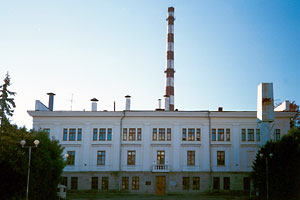

Listening to others: a personal view by Andrew
Teller, ENS society manager
50 years: the beginning of the end or the end of
the beginning?
Fifty years of peaceful uses of nuclear energy have
given rise to several celebrations the world over. Beginning in
2003 with the « Atoms for Peace » initiative, 2004
has seen two further events to commemorate the milestone. First,
the American Nuclear Society is celebrating its fiftieth anniversary
throughout the year, and also the first Russian civil nuclear
power plant at Obninsk was commemorated at the beginning of July
in an event co-sponsored by the IAEA and the Russian Nuclear Society.
It is worth noting that no similar events seem to have taken place
for fossil-fired power generation when these reached similar milestones.
Several reasons may account for this difference. The beginnings
of the world’s latest energy resource were precisely recorded,
making it easier to pinpoint anniversaries than for other fuels.
These beginnings also marked an about-turn in the way the power
of the atom was to be used, shifting from military to civil applications.
In any case, one cannot help thinking that these celebrations
implicitly acknowledge that nuclear energy is not quite like the
others. This observation is not meant to belittle its role: the
celebrations also serve to remind everybody that the advent of
a nuclear age was, at the time, expected to provide a sustainable
answer to mankind’s growing energy needs. Fifty years later,
following some initial oversell and systematic distrust ever since,
this possibility is still alive.
“Fifty Years of Nuclear Power – the
Next Fifty Years”: read the title of the Obninsk conference.
The very title would infuriate the critics of nuclear energy who
have been campaigning to phase it out well before another fifty
years pass . It is therefore useful to have a closer look at nuclear
power’s life expectancy. This leads us to examine two claims
often made by the opponents of nuclear energy: a) uranium reserves
are insufficient to guarantee its long-term use and b) the technology
is obsolete.

Let us first address the often-disputed issue of
the world’s uranium reserves. The NEA “Red Book”
puts known conventional resources at 4.6 million tons of uranium.
This is the most commonly accepted figure. It has been picked
up by sceptics to conclude that nuclear power generation (NPG)
would be short-lived, especially if installed capacity were to
grow, and hence not worth the trouble. A recent survey of the
situation was presented at the Obninsk conference by D. Grenèche
(AREVA, France). To summarise his detailed study in two sentences:
-
the world' s ultimate resources of uranium including speculative
and non conventional resources (except uranium from sea water)
could be in the range of 35 millions tons
-
assuming a healthy but realistic growth of NPG with thermal
reactors only, these reserves would be able to fuel reactors
until the end of this century. Full recycling of fissile materials
(reprocessed U and Pu) in thermal reactors would allow to
extend the utilisation rate of natural uranium by a few tens
of percentage points.
Where does this assessment place NPG in relation to other energy
sources? Well, the answer is, perhaps surprisingly, not far from
the position of fossil energy sources. History is especially informative
in this respect. It reveals that there has been a gradual change
over the past five hundred years in the energy mix used by Man,
at least in the western world. Wood was progressively replaced
by coal. In England the transition started as early as the 16th
century. Oil entered onto the scene in the beginning of the 19th
century, and was well implanted by 1850. The expansion of the
use of natural gas began around forty years ago, with the effect
of reducing the use of oil in many applications. Limited gas and
oil resources allow for the prediction that their expanded use
will be followed by a decline later in this century. If our energy
consumption rate is not to be drastically reduced, oil and gas
will have to be replaced in turn by new energy sources. Renewables,
fission (with or without a closed cycle) and fusion are the only
CO2-free candidates at present, although with very different technical
potentials. Hydrogen is not included in this list, as it is only
an energy carrier.
This short summary of five centuries of western history leads
to the following observation. People’s energy needs have
long been met by successive waves of different fuels, the general
trend being from solid to liquid to gaseous, with a steady decrease
in the carbon content. More importantly, nuclear’s potential
life expectancy without fast breeders would be in the range of
150 years, which is not much shorter than oil and gas. With fast
breeders it would actually exceed the lifetime of coal.

So much, then, for the limited resources. Let us now turn to
the question of obsolescence. It is a favourite claim of the opponents
of nuclear energy that the current generation III or III+ reactors
are only the latest embodiment of an antiquated technology dating
back to the fifties. If this thinking were applicable, it would
also be true to say that today’s cars should be dismissed
as the latest embodiment Ford’s T-Model. Those who say so
ignore decades of R&D and systematic use of experience feedback.
Reviewing anti-nuclear literature sometimes helps to highlight
the weakness of their arguments. In one pamphlet, the French Greens
explained that energy production technologies should be evolving
as quickly as is currently the case with Information Technology,
where all new advances are immediately implemented and brought
to the market place. In another pamphlet, the same Greens state
that in order to conserve energy, appliances should be designed
to last for as long as possible. On the basis of such conflicting
signals, it is impossible to decide whether laptops should be
built to last or not. One is also left wondering why power plants
should not likewise be designed for the long run, given the large
energy investment their erection represents. The Greens’
ambivalence regarding plant design lifetime does not, however,
stop the nuclear community from investigating other avenues for
NPG. This is clearly the goal of the Generation IV initiative,
but this project should in no way be seen as implying that the
current technologies are wanting.
Based on this evaluation, I conclude that there are no reasons
to expect a premature death of NPG due either to the exhaustion
of the required fuel resources or to technical inappropriateness.
All told, the organisers of the Obninsk conference might well
have titled their conference “the Next Hundred Years”.
They were probably wise, however, not to do so: so many things
can happen in one hundred years.
1 The phasing-out
time-scales advocated by the opponents of nuclear energy vary
noticeably: five years from the date the decision is taken (when
they are in the opposition), rising to twenty years or, at any
rate, after the first milestone of the Kyoto protocol, when they
are part of a government.
|








